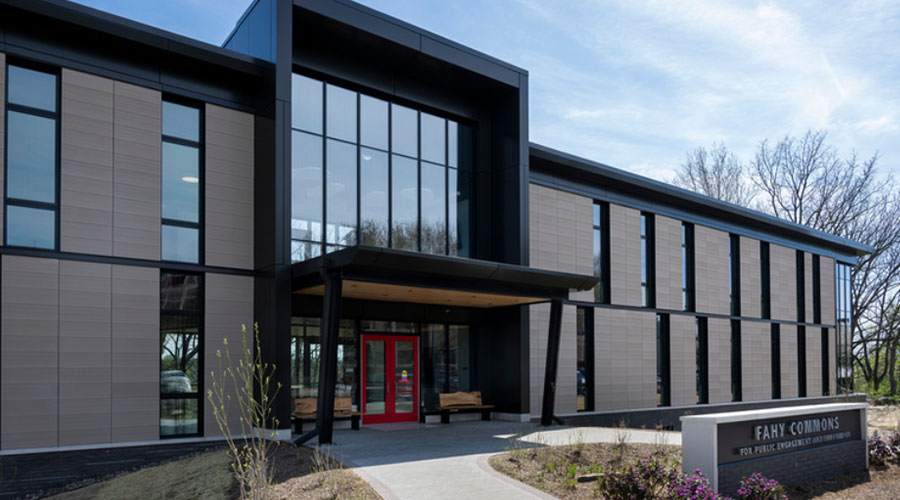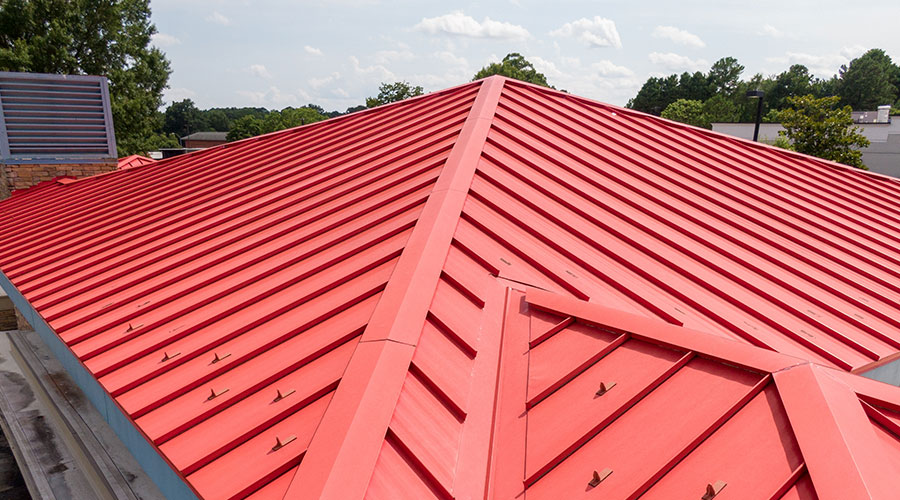Roof Coatings in a New Light
Once seen primarily as protection for roofing systems,
coatings gain growing attention for role in holding down cooling loads
One of the most commonly asked questions in the roofing industry is this: “How long should the roof last?” Although roofs fail prematurely due to unexpected external forces — including earthquakes, hail, hurricanes, tornados, and foot-traffic abuse — a primary reason for premature failure is regular and prolonged exposure to sun and wind.
All exterior-grade construction materials need to provide a means of fighting off sun and wind’s oxidizing effects, which result in aging. Roofing materials are in a league of their own in this regard, especially because their location makes them especially vulnerable. The roof is fully exposed to the sun’s rays and is elevated enough to allow wind to blow across it freely.
Exterior materials subjected to the deteriorating effects of aging and weather tend to diminish in performance. When materials are subjected to the roofing environment, deterioration from exposure and biological effects accelerates. The pressure on roofing materials to react or degrade is several times that of materials on the interior of the building.
In a growing number of institutional and commercial facilities, maintenance and engineering managers are specifying roof coatings to protect roofing systems and, in turn, a facility’s interior operations and components. Many managers also are more closely investigating the role light-colored and reflective coatings play in holding down buildings’ cooling loads.
Aging and Asphalt-based Roofing
Asphalt is a waterproofing agent and adhesive used in assembling multiple plies of organic or inorganic felts into one homogeneous roofing membrane, built-up roof systems. Manufacturers have used this type of construction successfully for decades, and it remains a common choice for roofing, with about 40 percent market share.
The asphalt used in built-up systems provides an excellent water barrier, but as with other materials, asphalt is highly subject to degradation from exposure, just as other materials are. Asphalt hardens progressively when exposed to roof temperatures. This occurs with all asphalt-based components, including cap sheets, saturated felts, and asphalt moppings.
Temperature changes cause the underlying asphalt to expand. Since the asphalt skin cannot stretch to accommodate the movement, random crack patterns appear to relieve the stress. Fresh asphalt is exposed below the broken skin.
Over time, the fresh asphalt within the cracks forms a new skin. The new skin layer will then eventually crack in the same line again, due to temperature changes, leaving a slightly deeper depression. This process repeats itself until the crack lines grow very deep and into the felts, allowing water infiltration.
A vital component of a successful built-up roof system is surfacing to protect the asphalt waterproofing component from the effects of exposure. The two most common methods of surfacing built-up roof membranes are a flood coat of aggregate embedded in asphalt or a mineral-surfaced cap sheet.
A cover of aggregate or minerals over the asphalt can minimize surface deterioration, but it has little effect on the hardening of the underlying asphalt. These types of surfaces simply do not keep the roof temperature from rising. In some cases, depending on the type of aggregate or color of minerals, they might absorb heat, further elevating temperatures.
So why are these two types of surfacing used most often? Because they provide a durable surface to withstand foot-traffic abuse, another important factor in roof longevity.
Coatings as Heat Control
Roof coatings have become a commonly used material to reduce heat exposure and the subsequent hardening of the vital asphalt waterproofing component of built-up roof systems. The two most commonly used types of roof coatings are aluminum and acrylic elastomers.
The ideal time to use coatings is at installation. Application at this point will immediately retard the aging process and significantly extend roof life. But managers also can specify coatings for preventive maintenance purposes, applying them on previously installed roofs to extend performance life. The important point here is understanding that no coating will make a bad roof good again.
Generally, roofs more than 15 years old that have not been maintained properly with coatings are not good candidates for preventive maintenance-type coatings. At some point, a roof system is so weathered or brittle that it is not cost-effective to apply a coating. Managers might want to schedule a technician to perform a core analysis of the roof membrane to determine the suitability of the roof’s condition to accept coatings.
Base flashings are an ideal place to use coatings. About 90 percent of all roof leaks occur at flashings, and they tend to degrade even faster then the roof’s field. This degradation occurs because the vertical surface of the flashing receives intensive ultraviolet exposure, and the flashing membrane tends to be made of fewer materials than the roof field, due to weight considerations related to the walls.
Aluminum coatings help reflect the sun’s rays. In effect, they keep the roof’s surface cooler and slow down the hardening of the asphalt. One disadvantage of aluminum coatings is that the aluminum particles that produce its reflectivity eventually break down and erode, producing a dulling action of the aluminum, thus reducing the coating’s reflectivity.
Also, the low elasticity nature of aluminum coatings does not prevent alligatoring of the coating, along with the alligatoring of the asphalt. Because of this dulling action, the roof needs to be recoated periodically — every two to four years — to revitalize the initial reflectivity properties.
Initially, an aluminum coating might be less expensive than an elastomeric coating, but it needs to be reapplied more often than the elastomeric product, so it might end up costing more in the long run.
Acrylic elastomeric coatings are single-component co-polymers or tar-polymers of acrylic monomers. Most are water-based — acrylic latex — coatings, which makes them easier to apply and clean up. Manufacturers can tint these coatings to produce various colors, but the most commonly used color is white because of its superior cooling effect on the roof.
Elastomeric coatings do not experience the particle breakdown that aluminum coatings do. As a result, they maintain their reflectivity and emissivity as long as they are on the roof. They do degrade over time and lose thickness, so managers might need to schedule recoating every 7-10 years.
Finally, managers should carefully and thoroughly scrutinize the manufacturer’s reputation prior to using their coatings. And any coatings used should be compatible with and accepted by the roofing membrane manufacturer to which it is being applied.
Alan Benson, RRC, is president of Alan Stevens Associates Inc. — www.alanstevens.com — a provider of roof asset management services headquartered in Cedar Rapids, Iowa. Benson has 26 years of experience in the roofing industry.
Finding The ‘Right’ Coating
When specifying a roof coating to protect a roof membrane, managers should how the coating measures up to a series of criteria. The coating:
-
must be compatible with the roofing materials to which it is applied
-
should be reflective and non-heat absorbing
-
should be fire resistant and meet code requirements
-
should maintain its properties for at least five years without the need for recoating
-
should have elastomeric properties to withstand normal roof movement
-
should be able to withstand normal foot traffic
-
should be able to resist water entry.
Also, the existing roof must have adequate slope to prevent prolonged ponding on the coating. Perhaps most importantly, managers should make sure that their goal in applying the roof coating is not to try making a bad roof good.
— Alan Benson
|
Roofing Resources
Asphalt Roofing
Manufacturers Association
1156 15th St. N.W., Suite 900
Washington, DC 20005
(202) 207-0917
www.asphaltroofing.org
National Roofing
Contractors Association
10255 W. Higgins Road, Suite 600
Rosemont, IL 60018
(847) 299-9070
nrca@nrca.net
www.nrca.net
Roof Coatings
Manufacturers Association
1156 15th St. N.W., Suite 900
Washington, DC 20005
(202) 207-0919
info@roofcoatings.org
www.roofcoatings.org
Single-Ply Roofing Institute
77 Rumford Ave., Suite 3B
Waltham, MA 02453
(781) 647-7026
info@spri.org
www.spri.org
White Coatings Council
c/o Roof Coatings
Manufacturers Association
1156 15th Street N.W., Suite 900
Washington, DC 20005
202-207-0919
info@roofcoatings.org
www.roofcoatings.org
|
Related Topics:











